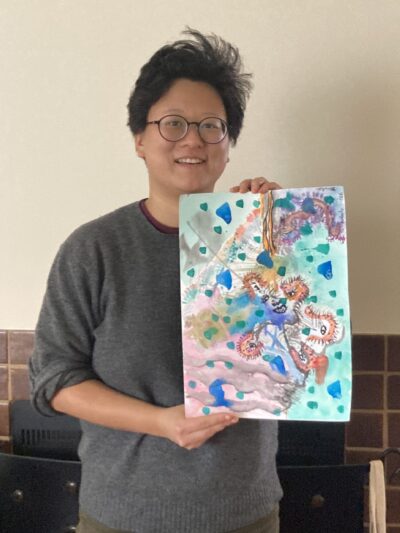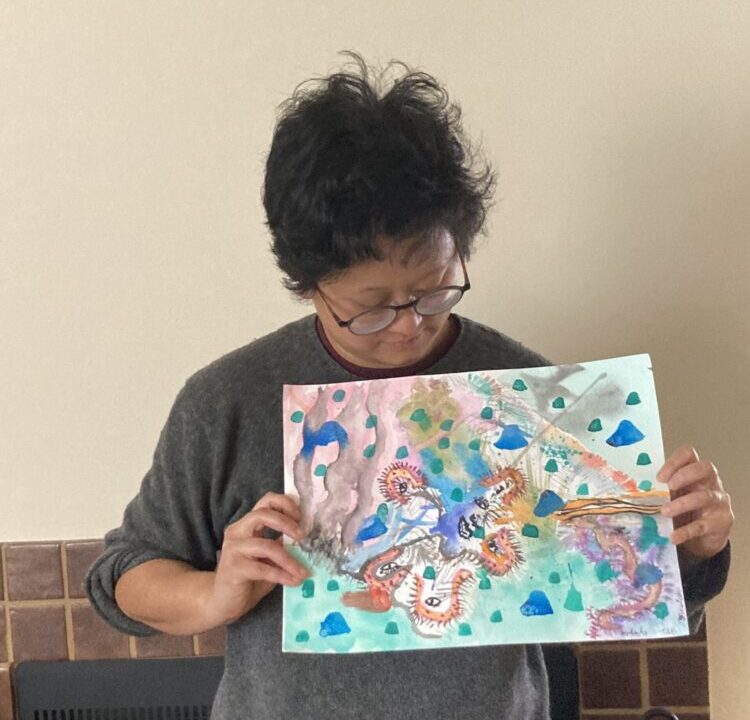Last autumn I traveled with two friends, Monique and Jacob, to a cabin in the western mountains of Maine. We called it a writing retreat. Monique brought books on craft; I carried around more pens than fingers. And we did write — outdoors at a lake’s edge, and indoors under a mounted moose head.
But for me, the lessons in creativity that weekend lay outside my notebook.
Jacob’s presence encouraged us to try activities beyond our typical word-based exercises, like free writing or playing variations on Mad Libs. Unlike Monique and me, Jacob isn’t a professional writer; he’s pursuing music. He brought his electric keyboard to the cabin, and he taught me to play “Miss Simone.”
“Miss Simone,” a song by Sara Bareilles, is about two people in love dancing on a rooftop, with a simple accompaniment that cycles through the same handful of chords. Jacob typed the progression into the Notes App on his phone and perched it on the keyboard for me. As I played, Jacob sang softly next to me, catching his voice between his throat and the keyboard to prevent too much echo in the cabin. I played the chords, often getting them out of order. But Jacob kept singing: Verse, pre-chorus, chorus and verse again. So I kept playing.
There is no revision in live performance. If you play a wrong note, you have no way to go back and correct it. I charged ahead to the next chord after messing up the last. Jacob tried a vocal riff at one point that sounded like a kettle boiling. But once the sound comes and goes, there’s no use dwelling on it. We move on to the next verse.
From chords to colors
Later, we collaborated on a watercolor painting. None of the three of us has a particular talent for visual art, but we each took turns dabbing Jacob’s watercolors onto a piece of white cardstock. Monique painted curved shapes, while Jacob pressed down a thick brush to create deep blue blobs. I swirled the watercolors in swaths to create a background of bleeding colors. We rinsed our brushes in a shared red Solo cup between each turn. All the while, we chatted about Monique’s grandma, who owned a nightclub in Connecticut during the 60’s and had encounters with a local group known as the Junior Mafia.
We stopped painting when we felt done. The painting had no obvious orientation, as we had each added strokes sitting at different vantage points of the cardstock. From one view, it looked like a pink landscape with a green sky; from another, like a portrait of a sea alien floating in an emerald ocean. By the end, we’d created something entirely unplanned, yet still complete. It looked like a Dr. Seuss fever dream, but the painting felt profoundly honest in its lack of premeditation. Each of us had no idea what the next person would paint, which meant we had to let go of any sort of vision and just focus on the paper in each moment.
My approach toward the music and the painting felt markedly different than my usual approach to writing. I tend to think of writing like building a house, where I have the completed blueprint — an outline — before any construction starts. I like to write the beginning and the end first, then complete the story like finishing a printed maze — by extending a line from both beginning and end until they connect.
This approach works when the stories are simple. In my work as a science journalist, I often find myself writing the same straightforward narratives: A team of scientists discovers something new about nature; an engineer invents a clever device to help society; a person overcomes a challenging childhood to become a successful researcher. But the full picture is often more complicated and more interesting, and I seek to weave more of that complication in my stories: Perhaps the discovery leads to weapons development; the engineer’s invention is unaffordable and commercially fails; the successful researcher is accused of harassing students. It’s not obvious where to begin or end those stories.
That’s when I try to tap into the mindset I discovered when playing “Miss Simone” and painting the shared watercolor. If I don’t know what the story is, I strive to put words down on the page like I’m learning the chords to a song, where mistakes are part of the process. As in creating the watercolor, I try to let go of my desire to know the end before I begin. I let myself write whatever flows.
Putting the practice to work

I attempted to follow this process to write this very article. I made myself start writing without knowing what I wanted to say, just that I wanted to write about learning the song and painting the watercolor. I definitely didn’t know how to structure the piece. But I set aside these uncertainties and wrote most of this article in a burst, without letting myself edit along the way. Some details surprised me: I had forgotten about the shared Solo Cup and Monique’s grandma.
Having blurted the words out on the page, I let myself start editing. I reread my writing to look for the main idea. After identifying the main point of the article, it became clear to me which paragraphs or sentences I needed to rearrange. The structure of the article emerged from the words, rather than from a planned outline. Then, I sent the draft to my editor, who suggested additions I could make, mostly for clarity and to draw a stronger connection between the singing/painting and my writing. I wrote those additions in another burst, then edited that.
Sometimes a writer doesn’t know what to write, nor how to write it. But sometimes we should just start writing. Sometimes an authentic story will emerge, and we can find the cohesion later.
* * *
Sophia Chen is a freelance science journalist based in Columbus, Ohio, who writes about physics, space, AI, and anything involving numbers.



